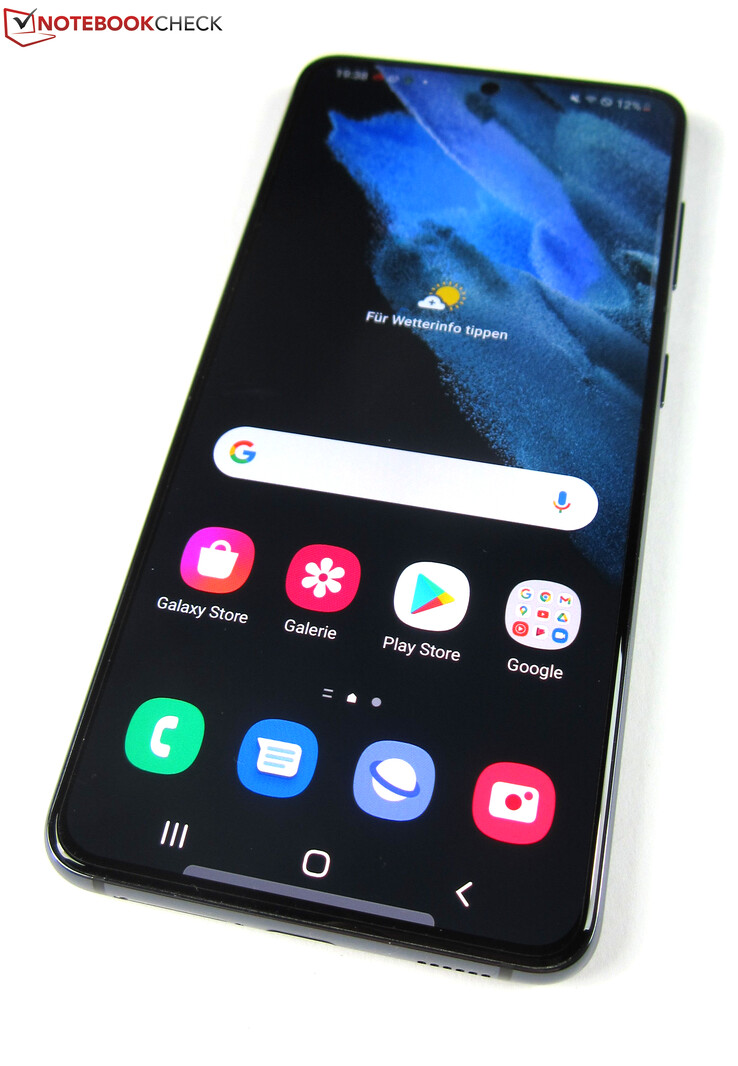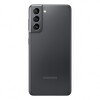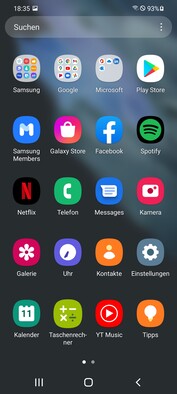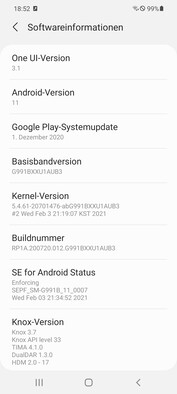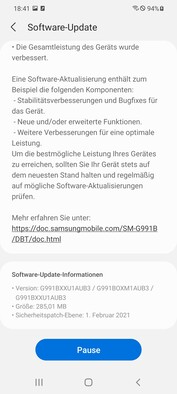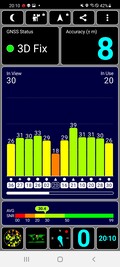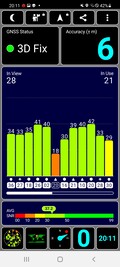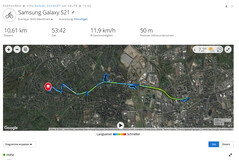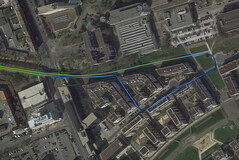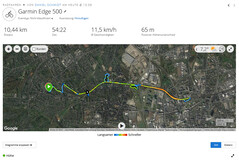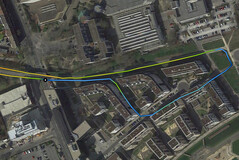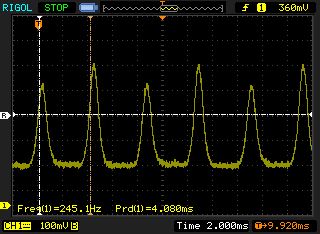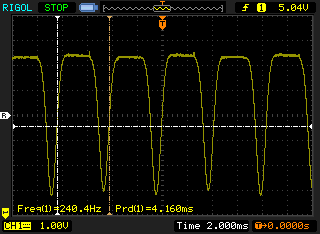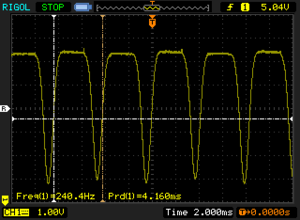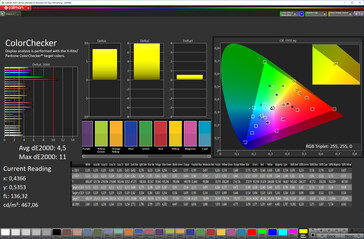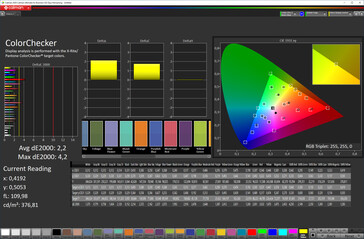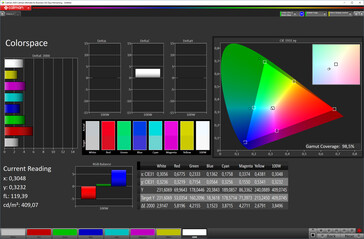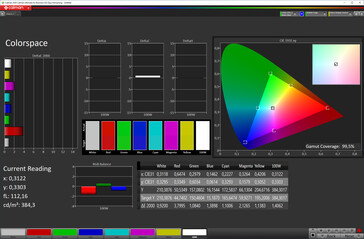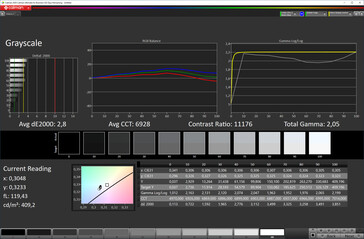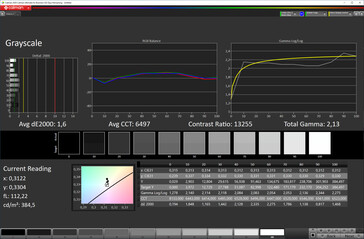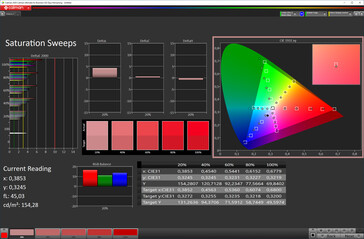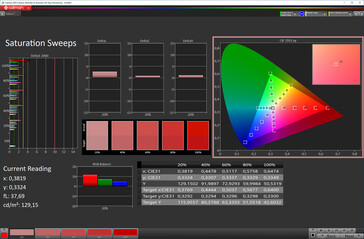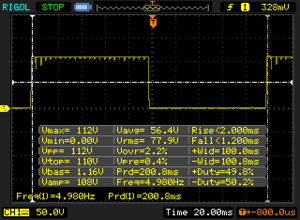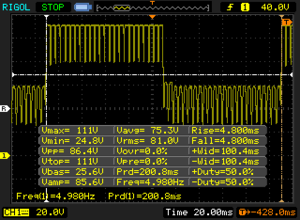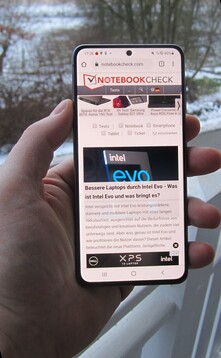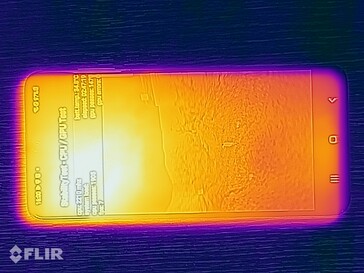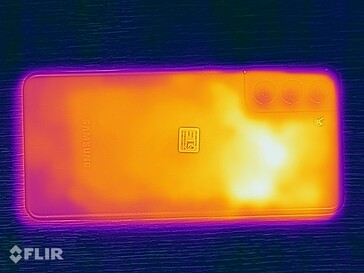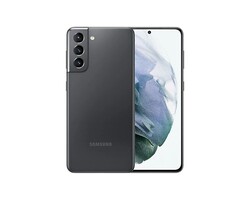Samsung Galaxy S21 smartphone review: The most affordable high-end Galaxy

Samsung has updated its Galaxy S20 flagship smartphone. The successor goes by the name of Galaxy S21, still serves the high-end segment, and is available in three variants, each aimed at slightly different target groups.
The Galaxy S21 series starts with our test candidate and all-rounder, the Galaxy S21. The smallest model of the Galaxy S21 lineup starts at 849 Euros (~$1,027) (MSRP); it's 6.2 inches large, has 8 GB of RAM as well as 128 or 256 GB of internal storage, and takes pictures with a 64 MP triple camera.
The Galaxy S21 is followed by the Galaxy S21+ (starting at 1,049 Euros (~$1,269)), which should primarily appeal to gamers and series fans with its 6.7-inch display. The flagship of the Galaxy S21 range takes it one step further: The Samsung Galaxy S21 Ultra starts at 1,249 Euros (~$1,510); it offers the largest display at 6.8 inches and also has the most versatile camera (108 MP) in addition to the strongest battery.
An overview of the differences between the Galaxy S21 models can be found here.
Possible contenders in comparison
Rating | Date | Model | Weight | Drive | Size | Resolution | Price |
|---|---|---|---|---|---|---|---|
| 89.5 % v7 (old) | 02 / 2021 | Samsung Galaxy S21 Exynos 2100 5G, Mali-G78 MP14 | 169 g | 128 GB UFS 3.1 Flash | 6.20" | 2400x1080 | |
| 88.2 % v7 (old) | 11 / 2020 | Apple iPhone 12 A14, A14 Bionic GPU | 162 g | 64 GB SSD | 6.10" | 2532x1170 | |
| 83.8 % v7 (old) | 11 / 2020 | Google Pixel 4a 5G SD 765G, Adreno 620 | 168 g | 128 GB UFS 2.1 Flash | 6.20" | 2340x1080 | |
| 89.4 % v7 (old) | 04 / 2020 | Huawei P40 Pro Kirin 990 5G, Mali-G76 MP16 | 209 g | 256 GB UFS 3.0 Flash | 6.58" | 2640x1200 | |
| 88.5 % v7 (old) | 04 / 2020 | OnePlus 8 Pro SD 865, Adreno 650 | 199 g | 256 GB UFS 3.0 Flash | 6.78" | 3168x1440 | |
| 87.9 % v7 (old) | 02 / 2021 | Samsung Galaxy S20 FE 5G SD 865, Adreno 650 | 190 g | 128 GB UFS 3.1 Flash | 6.50" | 2400x1080 |
Case - Galaxy S21 with a matte plastic chassis
The Galaxy S21 shares the light, slim, and IP68-certified case as well as the 20:9 display aspect ratio with its predecessor, the Galaxy S20, which is also 6.2-inches large; therefore, it's still well suited for smaller hands. However, the design has been completely revamped and makes the Galaxy S21 look more modern.
In contrast to the Galaxy S20, the almost bezel-less AMOLED display is no longer rounded at the corners and sides, but it's flat all the way through like in the Galaxy S20 FE. In turn, two design elements haven't changed: The ultrasonic fingerprint scanner is located underneath the display as before, and the selfie camera is once again centered at the upper edge of the screen.
The biggest differences compared to the predecessor are found on the back, where the camera setup immediately catches the eye. The metal frame that binds the display and back cover together also goes around the lens trio and lets it protrude a few millimeters from the case.
The back isn't made of glass like in the Galaxy S20; instead, it's only made of plastic - a glass back is only available starting with the Galaxy S21+. However, this isn't a disadvantage because the plastic back cover also feels high-quality. Thanks to its subtle texture, it also offers fingers a slight resistance, which makes the Samsung device feel more secure in the hand than a smartphone that has an all-around glass shell.
Samsung offers the Galaxy S21 in four matte case colors. Our test device is sporting the "Phantom Gray" color. Other colors are "Phantom White", "Phantom Pink", and "Phantom Violet".
Connectivity - 8 GB of RAM and at least 128 GB of storage
With 8 GB of RAM and 128 GB of UFS 3.1 storage, the Galaxy S21 officially costs 849 Euros (~$1,027). Samsung estimates 899 Euros (~$1,087) for the second variant with 256 GB. This makes the Galaxy S21 considerably cheaper than the Galaxy S20, which cost at least 999 Euros (~$1,208) in the 5G version.
The internal storage can't be expanded, because Samsung has removed the microSD slot that was still available in the predecessor. You also have to do without an audio jack, an IR blaster, and FM radio. There's no notification LED, but an always-on display that takes over its function is available instead.
The USB-C port works at USB 3.2 Gen. 1 speeds. It supports USB OTG as well as outputting the image signal via HDMI and DisplayPort adapters. Other connectivity features include Bluetooth 5.0, NFC, and ANT+.
Software - Android 11 and One UI 3.1
The Galaxy S21 runs Android 11 and Samsung's in-house user interface, One UI 3.1. There were two system updates during our testing period. They provided the smartphone with bug fixes and performance improvements and also brought the Android security patches up to the level of February 1 - you can't be any more up to date than that.
Samsung packs numerous apps into the ROM, which reduced the available storage to just under 100 GB in our 128 GB version. Besides Google apps, various Samsung tools are also on board, including the SmartThings smart home ecosystem, the DeX desktop mode, and the Bixby smart assistant. In addition, there's a handful of Microsoft apps and other applications like Facebook and Netflix.
Communication and GPS - 5G and Wi-Fi 6E
Like all Galaxy S21 models, the Galaxy S21 uses 5G without mmWave. The smartphone accommodates two nano SIM cards at the same time. An eSIM can also be activated instead of a physical SIM card.
The Galaxy S21 supports all current Wi-Fi standards including Wi-Fi 6E with VHT160 for data transfers in local networks. However, the smartphone has problems with the 160 MHz range when connected to our Netgear Nighthawk AX12 reference router. Reception is much slower than expected in both the sending and receiving directions, and it's not very stable either. In contrast, the Galaxy S21 achieves good transmission rates with VHT80.
The Galaxy S21 determines its location using the GPS, GLONASS, Beidou, and Galileo satellite navigation systems. The smartphone took some time indoors and only managed an accuracy of eight meters. Outdoors, our position was determined much faster and was accurate up to six meters.
In practical use, which we simulate with a short bike ride as usual, there was nothing to complain about in terms of the Galaxy S21's tracking capabilities. Compared with the Garmin Edge 500 professional navigation device, it lacked the last bit of precision, but it still tracked the route to the destination 10 kilometers away very accurately.
Telephone and call quality
The Galaxy S21 delivers good call quality. The voices of the persons on the other end of the line are transmitted very clearly, and the integrated noise cancellation reliably filters out all background noises. However, the smartphone can only convince to a limited extent in hands-free mode. Voices sound quite tinny here, and the smartphone shouldn't be held too far away due to the microphone's short range.
VoLTE and WLAN calls can be activated for both SIM cards. An eSIM can also be used instead of a nano SIM card.
Cameras - The same lens setup as in the Galaxy S20
The camera setup of the Galaxy S21 consists of three lenses that are also found in the Galaxy S20 in the same configuration. A 64 MP telephoto camera (1/1.72", F2.0, FOV 76°, OIS) is joined by a 12 MP wide-angle camera (1/1.76", F1.8, FOV 79°, OIS), and a 12 MP ultra wide-angle camera (1/2.55", F2.2, FOV 120°). Videos can be recorded at up to 8K and 24 FPS, and 4K videos at up to 60 FPS. The selfie camera manages 10 MP (1/3.24", F2.2, FOV 80°) and snaps very good selfies.
With its four cameras and 108-megapixel sensor, the Galaxy S21 Ultra is clearly ahead of the Galaxy S21 on the spec sheet, but the gap is much smaller in practice. The biggest technical difference is in the telephoto camera. The Galaxy S21 Ultra has two of them and achieves an optical magnification of up to 10x with them. The Galaxy S21, on the other hand, has to make do with a digital zoom that achieves a magnification of up to 30x. As the test image in scene 4 shows, the Samsung phone still manages decent zoom photos, even though the image sharpness already starts to suffer here.
Excluding zoom photos, pictures taken with the Galaxy S21 are of very good quality and convince with strong contrasts and natural-looking colors, even if they sometimes appear a bit too saturated. The lens trio can also extract a lot from the subjects in low-light conditions, whereby the best picture results can be achieved in Night Mode.
Image comparison
Choose a scene and navigate within the first image. One click changes the position on touchscreens. One click on the zoomed-in image opens the original in a new window. The first image shows the scaled photograph of the test device.
Daylight-Scene 1Daylight-Scene 2Ultra wide angle5x zoomLow light-PhotoUnder controlled lighting conditions, the Galaxy S21 can take sharp pictures of the test chart and capture colors very true to life. In low-light conditions (1 lux), however, the camera software has to help a lot, and only blurry images of the test chart are captured.
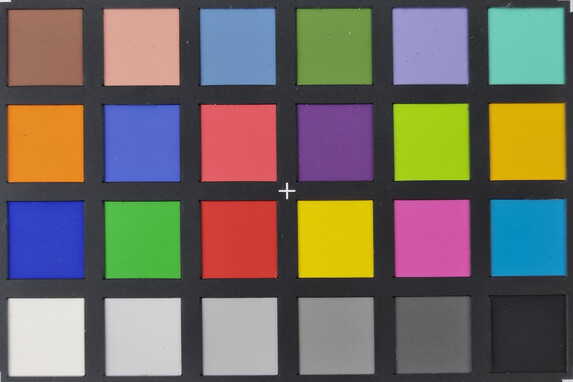

Accessories and warranty - Power adapter no longer included
Samsung has considerably slimmed down the Galaxy S21's scope of delivery. In contrast to the predecessor, there's no longer a power adapter, and the remaining accessories are also very straightforward: A USB cable (Type-A to Type-C), a SIM tool, a quick-start guide, and a leaflet with warranty information.
The absent power adapter can be purchased in Samsung's extensive accessories store as well as Bluetooth headphones or USB adapters. If you already have a USB-C power adapter, you can also use it to charge the Samsung phone.
The Samsung Galaxy S21 comes with a 24-month warranty that can be extended with the Care+ insurance package.
Input devices and handling - Very high system speed
Using the Samsung Galaxy S21 is as smooth as you would expect from a high-end smartphone. The AMOLED touchscreen responds to commands instantly, the in-display fingerprint sensor unlocks the smartphone quickly, and there's no lag when using the device, even with many apps running at the same time.
Display - FHD+ AMOLED panel at 120 Hz
The Galaxy S21's adaptive AMOLED display automatically adjusts its refresh rate to the content in the range of 48 to 120 Hz; in this way, it maintains the balance between saving power and providing smooth operation. Alternatively, you can also select a fixed refresh rate of 60 Hz.
The display has a resolution of 2400x1080 pixels, which is actually a clear step backwards compared to the Galaxy S20, since the latter offers 3200x1440 pixels. However, the lower pixel density isn't noticeable at all in practice, because the display still remains very sharp.
With an average of 793 cd/m², the display is very bright, and it distributes its luminance extremely uniformly across the screen (97%). We can even obtain up to 1,072 cd/m² from the AMOLED panel in the APL50 measurement, while the maximum is 413 cd/m² without the brightness sensor. We measured 1.59 cd/m² in the lowest brightness level.
The panel relies on pulse width modulation (PWM) for brightness control, which works in a low frequency range of up to a maximum of 245.1 Hz at display brightness levels below 99%. This can be bothersome for users with sensitive eyes.
| |||||||||||||||||||||||||
Brightness Distribution: 97 %
Center on Battery: 790 cd/m²
Contrast: ∞:1 (Black: 0 cd/m²)
ΔE ColorChecker Calman: 2.2 | ∀{0.5-29.43 Ø4.78}
ΔE Greyscale Calman: 1.6 | ∀{0.09-98 Ø5}
99.5% sRGB (Calman 2D)
Gamma: 2.13
CCT: 6497 K
| Samsung Galaxy S21 Dynamic AMOLED 2X, 2400x1080, 6.2" | Apple iPhone 12 OLED, 2532x1170, 6.1" | Google Pixel 4a 5G OLED, 2340x1080, 6.2" | Huawei P40 Pro OLED, 2640x1200, 6.6" | OnePlus 8 Pro AMOLED, 3168x1440, 6.8" | Samsung Galaxy S20 FE 5G Super AMOLED, 2400x1080, 6.5" | |
|---|---|---|---|---|---|---|
| Screen | 19% | 14% | 5% | 27% | -8% | |
| Brightness middle (cd/m²) | 790 | 642 -19% | 669 -15% | 584 -26% | 796 1% | 714 -10% |
| Brightness (cd/m²) | 793 | 639 -19% | 671 -15% | 576 -27% | 779 -2% | 721 -9% |
| Brightness Distribution (%) | 97 | 97 0% | 94 -3% | 95 -2% | 94 -3% | 95 -2% |
| Black Level * (cd/m²) | ||||||
| Colorchecker dE 2000 * | 2.2 | 0.9 59% | 1 55% | 1.1 50% | 0.68 69% | 1.8 18% |
| Colorchecker dE 2000 max. * | 4.2 | 2.42 42% | 1.8 57% | 2.3 45% | 1.55 63% | 5.1 -21% |
| Greyscale dE 2000 * | 1.6 | 0.8 50% | 1.5 6% | 1.8 -13% | 1.1 31% | 2 -25% |
| Gamma | 2.13 103% | 2.188 101% | 2.25 98% | 2.16 102% | 2.237 98% | 2.16 102% |
| CCT | 6497 100% | 6404 101% | 6685 97% | 6355 102% | 6310 103% | 6588 99% |
* ... smaller is better
Screen Flickering / PWM (Pulse-Width Modulation)
| Screen flickering / PWM detected | 240.4 Hz | ≤ 99 % brightness setting | |
The display backlight flickers at 240.4 Hz (worst case, e.g., utilizing PWM) Flickering detected at a brightness setting of 99 % and below. There should be no flickering or PWM above this brightness setting. The frequency of 240.4 Hz is relatively low, so sensitive users will likely notice flickering and experience eyestrain at the stated brightness setting and below. In comparison: 53 % of all tested devices do not use PWM to dim the display. If PWM was detected, an average of 8111 (minimum: 5 - maximum: 343500) Hz was measured. | |||
The Galaxy S21 offers two display modes, "Vivid" and "Natural". The former is the default setting; it covers the DCI-P3 color space and provides an intense color reproduction that isn't too accurate, though. In contrast, the AMOLED panel delivers quite realistic colors in the "Natural" display mode, but it only covers the smaller sRGB color space.
Display Response Times
| ↔ Response Time Black to White | ||
|---|---|---|
| 3.2 ms ... rise ↗ and fall ↘ combined | ↗ 2 ms rise | |
| ↘ 1.2 ms fall | ||
| The screen shows very fast response rates in our tests and should be very well suited for fast-paced gaming. In comparison, all tested devices range from 0.1 (minimum) to 240 (maximum) ms. » 13 % of all devices are better. This means that the measured response time is better than the average of all tested devices (20.2 ms). | ||
| ↔ Response Time 50% Grey to 80% Grey | ||
| 9.6 ms ... rise ↗ and fall ↘ combined | ↗ 4.8 ms rise | |
| ↘ 4.8 ms fall | ||
| The screen shows fast response rates in our tests and should be suited for gaming. In comparison, all tested devices range from 0.165 (minimum) to 636 (maximum) ms. » 22 % of all devices are better. This means that the measured response time is better than the average of all tested devices (31.6 ms). | ||
Thanks to its high brightness levels, the Galaxy S21's display is also very easy to read outdoors. It should still be easy to recognize the screen's content even in direct sunlight.
The viewing-angle stability of the AMOLED panel is very good. A slight greenish or bluish color veil appears sometimes from flat viewing angles as is typical for OLEDs, but this doesn't affect readability.
Performance - Strong competition for the Snapdragon 888
In Germany, all Galaxy S21 models use Samsung's new 5 nm Exynos 2100 SoC. In other regions, such as North America, the Galaxy S21 series is offered with the Snapdragon 888.
In the Galaxy S21, the Exynos 2100 relies on 8 GB of LPDDR5 RAM and is supported by the ARM Mali-G78 MP14 GPU. The octa-core SoC helps the Galaxy S21 achieve very good system performance; it makes web browsing a pleasure, and thanks to the UFS 3.1 flash storage, it loads apps very quickly.
The smartphone surpasses the prestigious 600,000-point mark in AnTuTu benchmarks and can even beat Apple's iPhone 12. However, performance in Geekbench 5.3 is no longer enough for the first place, which goes to Apple. The Galaxy S21 only scores moderately in the CPU-heavy 3DMark Sling Shot ES 3.1 physics tests.
| PCMark for Android | |
| Work performance score (sort by value) | |
| Samsung Galaxy S21 | |
| Google Pixel 4a 5G | |
| Huawei P40 Pro | |
| OnePlus 8 Pro | |
| Samsung Galaxy S20 FE 5G | |
| Average Samsung Exynos 2100 5G (15718 - 16777, n=3) | |
| Work 2.0 performance score (sort by value) | |
| Samsung Galaxy S21 | |
| Google Pixel 4a 5G | |
| Huawei P40 Pro | |
| OnePlus 8 Pro | |
| Samsung Galaxy S20 FE 5G | |
| Average Samsung Exynos 2100 5G (12255 - 14362, n=3) | |
| AnTuTu v8 - Total Score (sort by value) | |
| Samsung Galaxy S21 | |
| Apple iPhone 12 | |
| Google Pixel 4a 5G | |
| Huawei P40 Pro | |
| OnePlus 8 Pro | |
| Samsung Galaxy S20 FE 5G | |
| Average Samsung Exynos 2100 5G (600164 - 633158, n=3) | |
| AImark - Score v2.x (sort by value) | |
| Samsung Galaxy S21 | |
| Apple iPhone 12 | |
| Huawei P40 Pro | |
| Average Samsung Exynos 2100 5G (226728 - 241222, n=3) | |
| Jetstream 2 - 2.0 Total Score | |
| Apple iPhone 12 (Safari 14) | |
| Average of class Smartphone (23.8 - 387, n=153, last 2 years) | |
| Huawei P40 Pro (Huawei Browser 10.1) | |
| Average Samsung Exynos 2100 5G (65.1 - 76.6, n=3) | |
| Samsung Galaxy S21 (Chrome 88.0.4324.152) | |
| OnePlus 8 Pro (Chrome 80) | |
| Google Pixel 4a 5G (Chrome 86.0.4240.110) | |
| Samsung Galaxy S20 FE 5G (Chrome 81.0.4044.138) | |
| JetStream 1.1 - Total Score | |
| Apple iPhone 12 (Safari 14) | |
| Huawei P40 Pro (Huawei Browser 10.1) | |
| OnePlus 8 Pro (Chrome 80) | |
| Average Samsung Exynos 2100 5G (98.8 - 127.3, n=3) | |
| Samsung Galaxy S21 (Chrome 88.0.4324.152) | |
| Google Pixel 4a 5G (Chrome 86.0.4240.110) | |
| Samsung Galaxy S20 FE 5G (Chrome 81.0.4044.138) | |
| Speedometer 2.0 - Result 2.0 | |
| Average of class Smartphone (15.2 - 643, n=126, last 2 years) | |
| Apple iPhone 12 (Safari 14) | |
| Average Samsung Exynos 2100 5G (74.1 - 85.8, n=3) | |
| Samsung Galaxy S21 (Chrome 88.0.4324.152) | |
| Huawei P40 Pro (Huawei Browser 10.1) | |
| OnePlus 8 Pro (Chome 80) | |
| Google Pixel 4a 5G (Chrome 86.0.4240.110) | |
| Samsung Galaxy S20 FE 5G (Chrome 81.0.4044.138) | |
| WebXPRT 3 - Overall | |
| Apple iPhone 12 (Safari 14) | |
| Average of class Smartphone (38 - 380, n=34, last 2 years) | |
| Samsung Galaxy S20 FE 5G (Chrome 81.0.4044.138) | |
| Average Samsung Exynos 2100 5G (102 - 132, n=3) | |
| Samsung Galaxy S21 (Chrome 88.0.4324.152) | |
| OnePlus 8 Pro (Chrome 80) | |
| Google Pixel 4a 5G (Chrome 86.0.4240.110) | |
| Huawei P40 Pro | |
| Octane V2 - Total Score | |
| Apple iPhone 12 (Safari 14) | |
| Average of class Smartphone (2228 - 121337, n=201, last 2 years) | |
| Average Samsung Exynos 2100 5G (25656 - 28247, n=3) | |
| Samsung Galaxy S21 (Chrome 88.0.4324.152) | |
| Huawei P40 Pro (Huawei Browser 10.1) | |
| OnePlus 8 Pro (Chrome 80) | |
| Google Pixel 4a 5G (Chrome 86.0.4240.110) | |
| Samsung Galaxy S20 FE 5G (Chrome 81.0.4044.138) | |
| Mozilla Kraken 1.1 - Total | |
| Samsung Galaxy S20 FE 5G (Chrome 81.0.4044.138) | |
| Google Pixel 4a 5G (Chrome 86.0.4240.110) | |
| OnePlus 8 Pro (Chrome 80) | |
| Huawei P40 Pro (Huawei Browser 10.1) | |
| Samsung Galaxy S21 (Chrome 88.0.4324.152) | |
| Average Samsung Exynos 2100 5G (1744 - 1810, n=3) | |
| Average of class Smartphone (257 - 28190, n=156, last 2 years) | |
| Apple iPhone 12 (Safari 14) | |
* ... smaller is better
| Samsung Galaxy S21 | Google Pixel 4a 5G | Huawei P40 Pro | OnePlus 8 Pro | Samsung Galaxy S20 FE 5G | Average 128 GB UFS 3.1 Flash | Average of class Smartphone | |
|---|---|---|---|---|---|---|---|
| AndroBench 3-5 | -51% | -22% | -24% | -24% | -18% | 29% | |
| Sequential Read 256KB (MB/s) | 1648 | 945 -43% | 1775 8% | 1627 -1% | 1528 -7% | 1586 ? -4% | 2216 ? 34% |
| Sequential Write 256KB (MB/s) | 1095 | 228.7 -79% | 395.7 -64% | 730 -33% | 676 -38% | 763 ? -30% | 1837 ? 68% |
| Random Read 4KB (MB/s) | 309.7 | 168.6 -46% | 228.1 -26% | 208.3 -33% | 228.4 -26% | 243 ? -22% | 294 ? -5% |
| Random Write 4KB (MB/s) | 282.6 | 186.7 -34% | 271.8 -4% | 197.7 -30% | 218.4 -23% | 241 ? -15% | 334 ? 18% |
Games - Can't always deliver its full performance
With its high-end hardware, the Galaxy S21 is naturally able to run modern games smoothly. However, we're still allowed to nitpick, because we would've expected a slightly higher gaming capability in view of the processing power packed by the phone.
Let's take PUBG Mobile as an example: The shooter is limited to 30 FPS in the HD setting on the Galaxy S21, although a higher frame rate would have definitely been possible. This also happens on other smartphones, but the fact that we can't select the "Ultra HD" setting, i.e. the second-highest graphics preset, is a bit disappointing.
The smartphone can fully show off its 120 Hz display in Armajet but only briefly. The frame rate drops continuously shortly after the game starts. The display remains buttery smooth, but throttling takes place internally.
We determine the gaming frame rates with our test tool Gamebench.
Emissions - Strong throttling under load
Temperature
At 35.8 °C (~96 °F), the Galaxy S21 only gets lukewarm in the test, which means that it stays within the green area in terms of temperature. However, the smartphone has to put the brakes on the SoC repeatedly, so it can't use its high performance on a long-term basis. The low percentage in 3DMark's Wild Life stress test proves this. After 20 repetitions of the Wild Life benchmark, only 56.5% of the original performance is still available. GFXBench's stress test unfortunately didn't deliver a result because the app crashed every time the results were about to be displayed.
| 3DMark - Wild Life Stress Test Stability | |
| Samsung Galaxy S21 | |
(+) The maximum temperature on the upper side is 35.3 °C / 96 F, compared to the average of 35.2 °C / 95 F, ranging from 21.9 to 247 °C for the class Smartphone.
(+) The bottom heats up to a maximum of 35.8 °C / 96 F, compared to the average of 34 °C / 93 F
(+) In idle usage, the average temperature for the upper side is 26.8 °C / 80 F, compared to the device average of 32.9 °C / 91 F.
Speakers
The two speakers of the Galaxy S21 are equipped with Dolby Atmos surround sound. They produce a decent sound that scores points with clean mids and trebles, but basses are a bit too low overall.
Due to the lack of a 3.5 mm audio jack, the USB-C port and an optional USB adapter are the only options for connecting headsets and speakers to the smartphone with a cable. Wireless connectivity is possible via Bluetooth 5.0, which supports the SBC, AAC, aptX, and LDAC Bluetooth codecs.
Samsung Galaxy S21 audio analysis
(+) | speakers can play relatively loud (87 dB)
Bass 100 - 315 Hz
(-) | nearly no bass - on average 26.8% lower than median
(±) | linearity of bass is average (11.6% delta to prev. frequency)
Mids 400 - 2000 Hz
(+) | balanced mids - only 4.6% away from median
(+) | mids are linear (5% delta to prev. frequency)
Highs 2 - 16 kHz
(+) | balanced highs - only 3.5% away from median
(+) | highs are linear (2.4% delta to prev. frequency)
Overall 100 - 16.000 Hz
(±) | linearity of overall sound is average (17.7% difference to median)
Compared to same class
» 14% of all tested devices in this class were better, 8% similar, 78% worse
» The best had a delta of 11%, average was 35%, worst was 134%
Compared to all devices tested
» 34% of all tested devices were better, 8% similar, 58% worse
» The best had a delta of 4%, average was 24%, worst was 134%
Samsung Galaxy S20 FE 5G audio analysis
(+) | speakers can play relatively loud (90.1 dB)
Bass 100 - 315 Hz
(-) | nearly no bass - on average 20% lower than median
(±) | linearity of bass is average (9.8% delta to prev. frequency)
Mids 400 - 2000 Hz
(±) | higher mids - on average 7.3% higher than median
(+) | mids are linear (4.8% delta to prev. frequency)
Highs 2 - 16 kHz
(±) | higher highs - on average 9.5% higher than median
(+) | highs are linear (5.4% delta to prev. frequency)
Overall 100 - 16.000 Hz
(±) | linearity of overall sound is average (21.9% difference to median)
Compared to same class
» 44% of all tested devices in this class were better, 8% similar, 48% worse
» The best had a delta of 11%, average was 35%, worst was 134%
Compared to all devices tested
» 62% of all tested devices were better, 7% similar, 31% worse
» The best had a delta of 4%, average was 24%, worst was 134%
Battery life - With 4,000 mAh, only average battery runtimes can be reached
Energy consumption
Apple leads the way, Samsung follows suit: The Galaxy S21 smartphones are also sold without a power adapter. If you have one at hand, they can be charged at up to 25 watts, and wirelessly at up to 15 watts. Besides Fast Wireless Charging 2.0, they also support Wireless PowerShare.
In terms of power consumption, the Galaxy S21 is in the midfield of our comparison devices. Idle power consumption is low, but the smartphone consumes a lot of battery power under load.
| Off / Standby | |
| Idle | |
| Load |
|
Key:
min: | |
| Samsung Galaxy S21 4000 mAh | Apple iPhone 12 2815 mAh | Google Pixel 4a 5G 3885 mAh | Huawei P40 Pro 4200 mAh | OnePlus 8 Pro 4510 mAh | Samsung Galaxy S20 FE 5G 4500 mAh | Average Samsung Exynos 2100 5G | Average of class Smartphone | |
|---|---|---|---|---|---|---|---|---|
| Power Consumption | 7% | 45% | 26% | -57% | 26% | 9% | 5% | |
| Idle Minimum * (Watt) | 1.1 | 0.9 18% | 0.7 36% | 0.92 16% | 2.2 -100% | 0.75 32% | 0.967 ? 12% | 0.848 ? 23% |
| Idle Average * (Watt) | 1.61 | 1.5 7% | 0.96 40% | 1.41 12% | 3.3 -105% | 1.41 12% | 1.357 ? 16% | 1.434 ? 11% |
| Idle Maximum * (Watt) | 1.78 | 1.8 -1% | 0.98 45% | 1.47 17% | 3.7 -108% | 1.44 19% | 1.437 ? 19% | 1.618 ? 9% |
| Load Average * (Watt) | 6.47 | 5.5 15% | 2.95 54% | 3.35 48% | 5.9 9% | 3.84 41% | 6.42 ? 1% | 7.01 ? -8% |
| Load Maximum * (Watt) | 10.12 | 10.4 -3% | 5.2 49% | 6.37 37% | 8.3 18% | 7.67 24% | 10.2 ? -1% | 11.3 ? -12% |
* ... smaller is better
Battery life
With its 4,000 mAh battery, the Galaxy S21 has the smallest battery in the S21 lineup - the Galaxy S21+ has 4,800 mAh, and the Galaxy S21 Ultra 5,000 mAh.
The small battery doesn't prove to be particularly enduring in the test. It's only really able to convince in the video playback test scenario, where it lasts for almost 16 hours. In contrast, the Galaxy S21 only manages 9:04 hours of web surfing, which isn't a very impressive result. At least the web surfing runtime can be extended by about 1.5 hours when the display is switched to 60 Hz.
| Samsung Galaxy S21 4000 mAh | Apple iPhone 12 2815 mAh | Google Pixel 4a 5G 3885 mAh | Huawei P40 Pro 4200 mAh | OnePlus 8 Pro 4510 mAh | Samsung Galaxy S20 FE 5G 4500 mAh | |
|---|---|---|---|---|---|---|
| Battery runtime | 38% | 38% | 4% | 28% | 21% | |
| Reader / Idle (h) | 28.6 | 43.4 52% | 41 43% | 24.6 -14% | 35.1 23% | 33.5 17% |
| H.264 (h) | 15.7 | 18.9 20% | 22.3 42% | 19 21% | 17.1 9% | 20.5 31% |
| WiFi v1.3 (h) | 9.1 | 15.8 74% | 12.8 41% | 12.4 36% | 15.4 69% | 12.7 40% |
| Load (h) | 4.5 | 4.7 4% | 5.7 27% | 3.3 -27% | 4.9 9% | 4.3 -4% |
Pros
Cons
Verdict - Cautious upgrade with fresh design
Part of Samsung's smartphone philosophy is to offer every user the device that is perfectly right for them. The Galaxy S21 series is no different.
The Galaxy S21 serves the largest target group among Galaxy S fans. It's the most affordable in the Galaxy S21 lineup, but it has almost the same features as its more expensive counterparts, the Galaxy S21 and Galaxy S21 Ultra, with a few exceptions. It's also just as fast since all three use the same SoC with the Exynos 2100.
Compared with the Galaxy S20, Samsung takes a few features away from the smallest version of its flagship smartphone, but it also adds quite a few. This definitely includes the fresh design, which makes the Galaxy S21 look much more modern. The new Exynos SoC and the bright AMOLED display are also clear plus points.
The Samsung Galaxy S21 offers excellent performance at a fair price. On the other hand, there are also only a few changes compared with its predecessor, the Galaxy S20.
The plastic back can be counted among the drawbacks, even though it doesn't look or feel like plastic. However, there are clear minus points for the missing audio jack, the microSD slot that has also been omitted, and the battery runtimes that are not all that impressive.
Overall, the changes compared with the Galaxy S20 are quite minor. Users who already own the predecessor don't necessarily have to upgrade to the Galaxy S21. Newcomers can definitely buy it, though, and they'll get a strong high-end smartphone for relatively little money.
Price and availability
At the time of writing, you can find the 256 GB international version on Amazon in Phantom Gray for $799.99 and in Phantom Pink for $809.90. Best Buy currently has a discount on the S21 lineup and has the Phantom Gray model with 256 GB of storage for $749.99 ($100 off) if you activate with a carrier on the same day and for $799.99 ($50 off) if you activate later. Best Buy also has other color variants with 128 GB of storage space such as the Phantom Violet one. However, because of the current discounts that are less for the 128 GB models, the pricing is the same for the latter as for the 256 GB model.
Samsung Galaxy S21
- 08/31/2022 v7 (old)
Manuel Masiero




